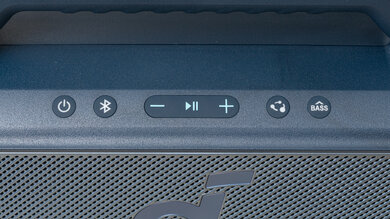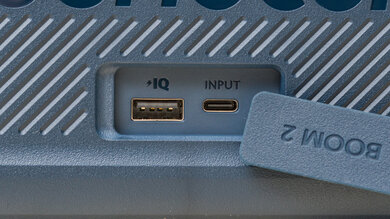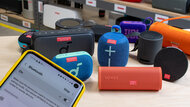The Anker Soundcore Boom 2 is the latest portable speaker offering from Anker. Like the Anker Soundcore Motion Boom Plus, it comes in a neat and portable boombox-style package that you can easily bring around with you. It's IPX7 rated, so it can be fully submerged, and the manufacturer even advertises that it can float on water. Plus it features a long enough battery life to get you through multiple listening sessions without a recharge.
Our Verdict
The Anker Soundcore Boom 2 is okay for music. Like most smaller speakers, it struggles to produce low-bass frequencies, even with BassUp enabled. It also has a somewhat veiled treble response that can make sibilants, like cymbals, dull and lacking brilliance. It has a balanced mid-range response, so lead instruments and vocals sound clear and detailed. While it can get loud enough to fill an average-sized room with sound, there's some compression at max volume. Directivity isn't the best, so audio won't sound consistent from all angles around the speaker.
- EQ and presets via the companion app.
- Can connect up to two devices simultaneously.
The Anker Soundcore Boom 2 is mediocre for movies and videos. Like many smaller speakers, it lacks bass, so the blaring horns of Hans Zimmer's soundtracks will lack some oomph. However, its balanced mid-range will bring detail and clarity to vocals and dialogue. While loud enough to fill a living room with sound, you'll notice some compression at max volume. You'll want to be careful about positioning yourself around the speaker, though, as its disappointing directivity means audio won't sound consistent from every angle. On the upside, audiovisual synchronization error falls within good limits for both iOS and Android devices, so you're unlikely to experience any lip-synch issues. However, apps and devices compensate for this differently.
- Lightweight, portable design with carrying handle.
- EQ and presets via the companion app.
The Anker Soundcore Boom 2 is decent for podcasts. It's balanced mid-range is great for rendering speech and vocal content in a clear, detailed manner. It can also get reasonably loud, and while there's compression at max volume, it's mostly limited to bass frequencies that don't feature too much in podcast content. It's portable enough to bring around from room to room, too, but you'll want to be careful to position yourself in front of the speaker, as its directivity is disappointing.
- Lightweight, portable design with carrying handle.
- EQ and presets via the companion app.
The Anker Soundcore Boom 2 lacks voice assistant capabilities, so it's unsuitable for this use.
The Anker Soundcore Boom 2 is good for outdoor use. Its lightweight design and built-in carrying handle make it a breeze to carry around for day trips or outdoor occasions, and its 16 hours of continuous battery life means it can make it through a weekend without needing a recharge. While it isn't loud enough to soundtrack a large outdoor bash, it can liven up a backyard BBQ, though there will be some compression as you approach max volume. Not everyone will experience the same audio delivery, though, as its disappointing directivity means that audio isn't consistent from every angle.
- Lightweight, portable design with carrying handle.
- 16 hours of continuous battery life.
- Can connect up to two devices simultaneously.
Changelog
- Updated Oct 16, 2024: The Frequency Response Accuracy section has been updated to mention the Anker Soundcore Boom 2 Plus.
- Updated Aug 01, 2024: We've added a comparison between this speaker and the JBL Xtreme 4 in Build Quality.
- Updated Jul 15, 2024: We've added a comparison between this speaker and the Anker Soundcore Rave Neo 2 in Dynamics.
- Updated May 09, 2024: We've added a graph showcasing how the different EQ presets affect this speaker's sound profile in Frequency Response Accuracy.
Check Price
Differences Between Sizes And Variants
The Anker Soundcore Boom 2 comes in three color variants: 'Phantom Black,' 'Explorer Blue,' and 'Adventure Green.' We tested the 'Explorer Blue' version and expect all variants to perform similarly. You can see our unit's label here. If you encounter a different variant of this speaker, please let us know in the forums, and we'll update our review.
Popular Speaker Comparisons
The Anker Soundcore Boom 2 is Anker's latest portable speaker offering, following on from the Anker Soundcore Motion Boom Plus. It has a similar boombox-style design to its predecessor, though it's a touch lighter. The two also have extremely similar sound profiles, with a lackluster bass response and a veiled treble range. The Motion Boom Plus can get louder and has rudimentary voice assistant capabilities, meaning it's a more versatile choice. Both speakers are also hampered by their disappointing directivity, so you might want to consider a portable speaker with a cylindrical design like the Ultimate Ears WONDERBOOM 3 if you care about getting consistent audio delivery from every angle.
You can also check out our recommendations for the best Bluetooth speakers, the best-sounding Bluetooth speakers, and the best Bluetooth speakers for bass.
The Anker Soundcore Boom 2 offers comparable performance to the JBL Xtreme 4 when it comes to sound at a price point that will suit those on a budget. The two speakers have similar sound profiles, which can be tweaked via the graphic EQ and presets in their respective apps, as well as similar performance when it comes to dynamics and soundstage. That said, the JBL justifies a higher outlay due to its better build quality (with a certification against dust damage) and a battery life that's almost double that of the Anker.
The Anker Soundcore Boom 2 Plus is a beefed-up version of the Anker Soundcore Boom 2. The additional size and heft translate to a more bass-heavy sound and a better dynamics performance, though both speakers have some underemphasis between the high-mids and mid-treble that can take some sparkle away from vocals and lead instruments. The Soundcore Boom 2 is more portable, better built and has a slightly longer battery life, so it's still a more ideal choice for outdoor and on-the-go use.
The Anker Soundcore Motion Boom Plus and the Anker Soundcore Boom 2 are very similar speakers, but the older iteration has the edge in a few areas. They're both well-built portable speakers with built-in carrying handles, but the Motion Boom Plus has an IP67 certification against dust damage and is submersible in water. The two have very similar sound profiles that lack bass and treble output, but their balanced mid-ranges mean vocals and speech are reproduced cleanly. They both have disappointing directivity, too, so you must be careful about positioning yourself in front of the speaker. While the Boom 2 is lighter, it can't get as loud, and there's more compression present at max volume.
The Anker Soundcore 3 and the Anker Soundcore Boom 2 are both budget portable speakers. While the Soundcore 3 is lighter, the Boom 2 features a built-in carrying handle, which can make it easier to carry around. The Soundcore 3 is cheaper, but the Boom 2 justifies its higher retail price with a better overall performance. It's better built, has a more balanced sound overall, and it can get louder with less compression at max volume. It also lets you pair with another Anker speaker for true wireless stereo via the app. The Soundcore 3 has a slightly longer continuous battery life, so it's a good choice for weekend trips.
Test Results

The Anker Soundcore Boom 2 utilizes the same boombox-style design as the other Motion Boom series speakers. This iteration is a little more rectangular than the Anker Soundcore Motion Boom Plus, but it retains the same carry handle, RGB lights, and backlit buttons. A metal grille with the Anker logo protects the front-facing drivers, and the sides are protected by rubber paneling that also houses the RGB lights. It comes in three color variants: 'Phantom Black,' 'Explorer Blue,' and 'Adventure Green.'
This speaker has a very good build quality. While it's almost entirely constructed from cheap-looking plastic, it's surprisingly sturdy and complemented by the tough metal grilles at the front. The physical buttons are tactile and clicky, and the RGB lights are bright and colorful. It's rated IPX7, so it can be fully submersed in water, and while there's no IP rating for protection against dust, Anker's marketing highlights the speaker's ability to be used in environments like the beach. If you're looking for a similarly-sized speaker that's rated against both dust and water damage, it's worth checking out the JBL Xtreme 4.
The controls are simple yet well formatted. The buttons are easy to locate and press, even in the dark, as they're all backlit. There's audio feedback when a device is pairing and paired, when the BassUp feature is toggled, and when the PartyCast mode is toggled. However, no audio feedback indicates when the volume has been adjusted, or playback has been paused.
- Power button: Press to power the device on/off.
- BassUp button: Activates the BassUp preset to bring more punch to the mix.
- Bluetooth button: Press once to enter pairing mode. Press and hold to enter TWS mode.
- Play/pause button: Press to play/pause, press twice to skip forward, or three times to skip backward. Hold for two seconds to activate the paired device's voice assistant.
- PartyCast button: Lets you pair the device to another compatible speaker for multi-speaker party mode.
With the BassUp feature on and the EQ set to the default 'Soundcore Signature' preset, this speaker has a sound profile that's remarkably similar to its predecessor, the Anker Soundcore Motion Boom Plus. As expected from a small speaker, it doesn't reproduce too much low bass, even with BassUp enabled. Fans of genres like EDM and hip-hop will be left wanting as basslines and kicks lack boom and substance. You can always opt for the beefed-up Anker Soundcore Boom 2 Plus, though, which features a more prominent low-end. However, the mid-range is balanced and can reproduce vocals and lead instruments in some detail. A dip in the high-mid response carries over into the treble range, though, which can render sibilants, like cymbals, a little dull and lacking in bite. That said, there's a graphic EQ and presets accessible via the companion app that you can use to tweak the sound to your liking. You can see how these presets affect the sound profile here.
This speaker's soundstage performance is okay. Due to its front-facing design, directivity is disappointing, and audio won't sound the same across different angles. It can playback stereo content without downmixing to mono, allowing for a clear separation between the left and right channels.
The dynamics performance is passable. This speaker can't get as loud as its predecessor or the slightly larger Anker Soundcore Rave Neo 2, but it's still loud enough to fill an average-sized room with sound. There's quite a bit of compression at max volume, though, so you'll hear some pumping artifacts that detract from the clarity of your audio.
The Anker Soundcore Boom 2 has an impressive battery life. The manufacturer advertises up to 24 hours of battery life online and 18 hours in the owner's manual, but we achieved 16 hours of continuous battery life in testing. This is likely due to a difference in testing conditions, as using functions like BassUp or playing music at a high volume will result in a shorter battery life. There's even a handy auto on/off power-saving function that'll turn the speaker off after 20 minutes of inactivity.
The Soundcore app gives you access to a host of different parameters you can tweak. You can choose from four different EQ settings (Soundcore Signature, Voice, Treble Boost, and Balanced) and make custom EQ presets. You can adjust the PartyCast settings to pair up to 100 speakers, adjust the button brightness, and update the speaker firmware. You can see a video of the app in action here.
This speaker doesn't have an AUX input or an input for USB audio. There are USB-A and USB-C ports, though, with the former used to charge other USB devices and the latter used to charge the speaker.
The Bluetooth performance is excellent. This speaker supports multi-device pairing, so you can pair up to two devices simultaneously. Audiovisual synchronization error is reasonably low with Android devices and lower with iOS devices, so you won't notice much in the way of lip-synch issues. Some apps and devices compensate for this differently, so your experience will vary.

































